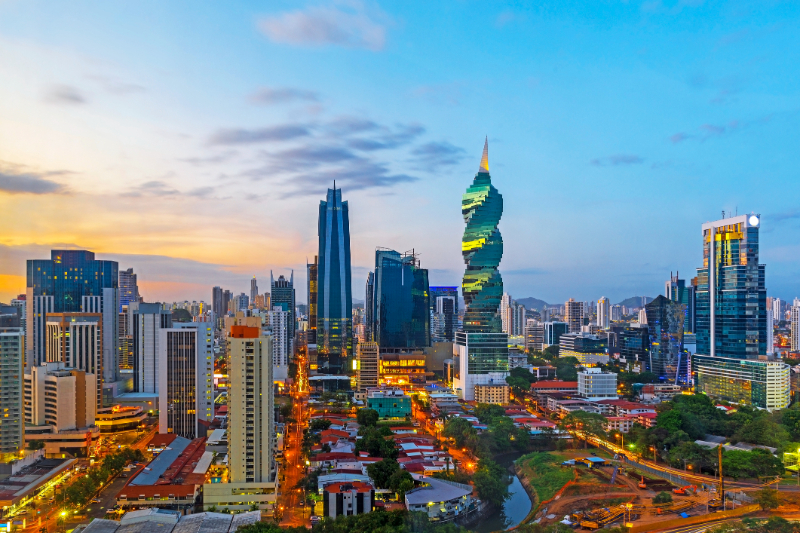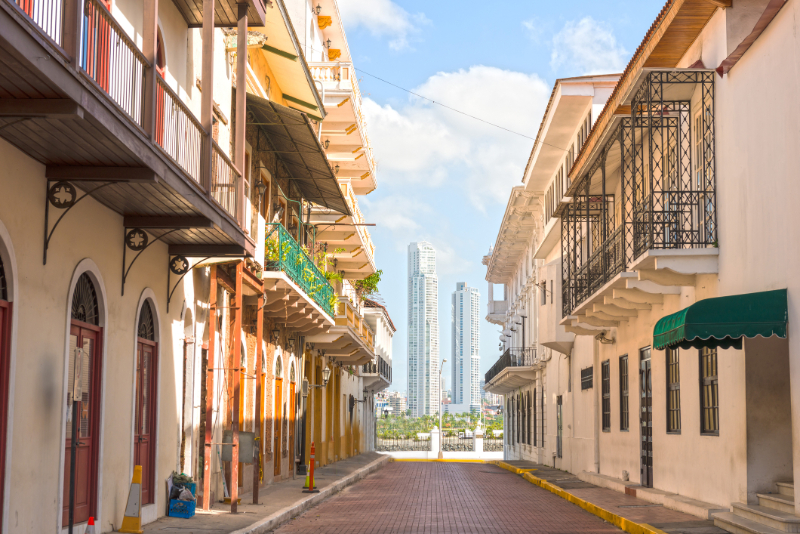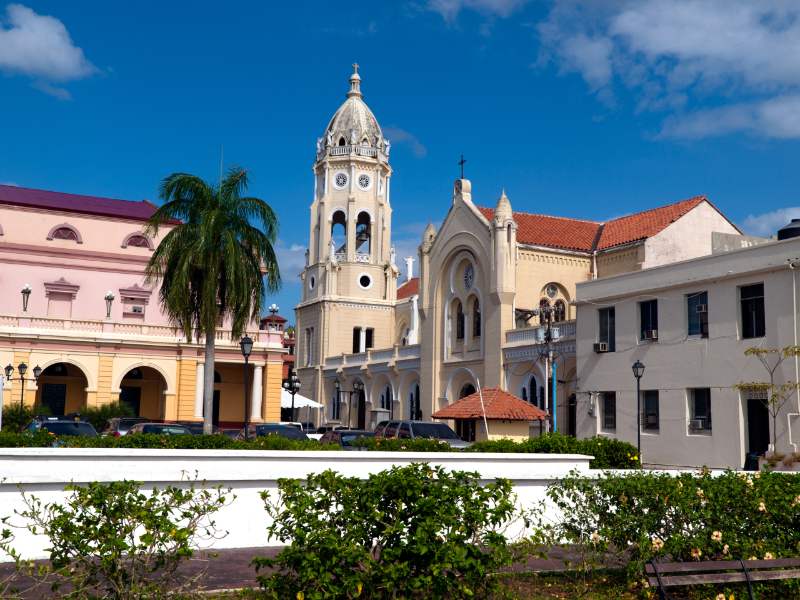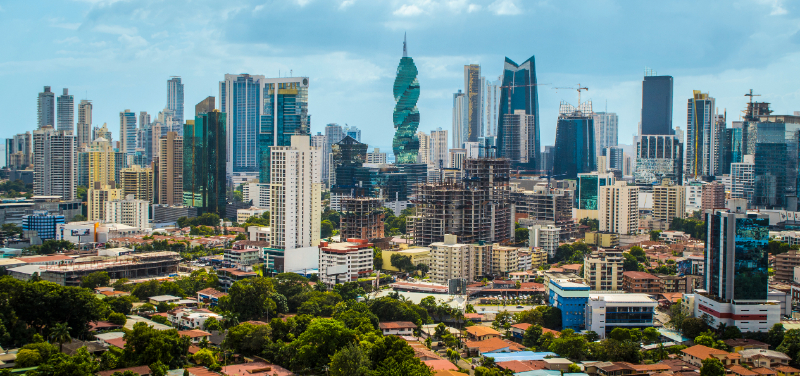Main Content
Panama
Real Estate
Table Of Contents
Introduction to
Panama Real Estate
History meets modernity in Panama City, whose colonial quarters stand alongside glass-clad towers. Located on the Pacific coast, this cosmopolitan city is the capital of Panama, a democratic nation and the southernmost country in Central America. It serves as the economic, logistics, and political center of Panama, offering a unique cultural experience to expats from around the world.
Known as the “Crossroads of the World”, it lies at the halfway point between North and South America. Primarily known for the Panama Canal, locally known as “Canal de Panamá”, a primary maritime conduit between the Pacific and Atlantic, the city has transformed into a world-class destination with its glittering skyline and scenic oceanfront walkway.
Divided into several districts, the city is full of character. From the narrow cobblestone streets of Casco Viejo to the upscale apartments and offices of Costa del Este, adventure awaits in every corner. The downtown area harbors some of the finest Panama City, Panama real estate. It is filled with towering skyscrapers and luxury high-rises, including distinctive works of architecture such as the Panama Bay Towers, Trump Ocean Club, and F&F Tower, also called “El Tornillo”, a 52-story skyscraper shaped like a screw.
Location
Panama City is framed by the Pacific and the man-made Panama Canal. Though its exact boundaries vary, its general boundaries include the Pacific coast to the north; the Panama Canal entrance and Panama Canal Zone to the east; the district of La Chorrera and various suburban and rural landscapes to the west; and the district of Arraiján and several suburban and rural communities to the south.
The Republic of Panama is a narrow strip of land flanked by the sea on either side and runs east to west. It shares a border with Colombia to the east and Costa Rica to the west. The Pacific coastline lies on the southern edge while the Caribbean Sea borders the northern side. Panama City is roughly located in the center of the country.
Size and Population
As the largest city in Panama, it encompasses approximately 275 square miles. The city center is home to a population of 880,691 while the metropolitan area has over 1.5 million residents. The international migrant population is 313,000 as of 2020. As many as 119,553 of the total international migrant population comes from Venezuela.
An estimated 20,000 to 30,000 American expatriates live in Panama, which is a top destination for American retirees – International Living ranked Panama #1 on the World’s Best Places to Retire in 2022 due to the comfortable lifestyle and gorgeous weather. There was also a strong U.S. military presence for decades. The expat population is distributed throughout Panama City as well as the areas of Boquete and Coronado.
What Panama City is Known For
In addition to the Panama Canal, the city is known for Casco Viejo, a historic center with sun-drenched plazas and colonial-era landmarks like the neoclassical Palacio Presidencial, which dates back to 1673. Another point of interest is the Miraflores Locks, which features exhibitions and observation decks with sweeping views of ships passing through the canal.
Aside from its rich cultural heritage and remarkable architecture, Panama City is known as an international banking and financial center with a vibrant business climate. Numerous multinational corporations have their headquarters in the city and contribute significantly to the economy. Panama City, Panama real estate is highly sought among expatriates and wealthy locals due to its proximity to shops, restaurants, and cafes.
Despite being a bustling urban center, Panama City is celebrated for its biodiversity. It is located within close proximity to natural wonders such as the Metropolitan Natural Park and Soberania National Park, with tropical rainforests that serve as habitat to a diverse range of plants, trees, and wildlife.

History
Before the arrival of Spanish settlers, the area that makes up present day Panama City was inhabited by indigenous tribes like the Coclé and Cueva peoples, who subsisted on agriculture, fishing, and trade. Spanish explorer Rodrigo de Bastidas set foot in the region in 1519 and the town of Panama Viejo (Old Panama) became the first permanent European settlement on the Pacific coast of the Americas in 1521.
Panama Viejo served as an important hub for the exportation of goods from South America to Spain. Because of its prosperity and location, it became the target of pirates, with Welsh pirate Henry Morgan sacking and burning the city in 1671. Panama City was then relocated to Casco Viejo in 1673.
During the Spanish Colonial era, Panama City became an important center for trade and transportation. The construction of the Panama Canal began in the late 19th century with the United States taking over the project in 1904. It was completed in 1914 and established Panama City as a major international transportation hub.
Panama declared its independence from Colombia on November 3, 1903 with U.S. support. The Hay-Bunau-Varilla Treaty gave the U.S. control over the Panama Canal Zone. However, control of the Panama Canal was officially transferred to Panama on December 31, 1999, paving the way for modernization and urban development.
PANAMA CITY, PANAMA REAL ESTATE
An overview of Panama City real estate
The Panama City housing market is a stable and steadily growing market that offers many opportunities for buyers and investors. From established neighborhoods to modern condo towers, Panama City offers prime real estate combined with new infrastructure.
Property Types
Panama City, Panama real estate offers a wide range of condos and villas. These include sleek homes with upscale finishes, spacious balconies, and views of the Pacific and city skyline. Some of the most sought-after properties in the area include waterfront homes and beachfront lots. Playa El Tuco, a small beach in Casco Viejo, harbors an exclusive selection of beachfront properties located within close proximity to the city center.
Typical Home Features and Architectural Styles
There's a wealth of European architectural styles in Panama City. Mediterranean and Spanish Colonial architecture is prevalent in historic and established districts throughout the city. For newer homes, buyers can choose from sleek condos and villas with Modern and Contemporary-style architecture.

Typical Community Amenities
Upscale condo and apartment complexes typically have shared amenities such as swimming pools, sun decks, observation decks, and rooftop gardens that help residents enjoy Panama City's scenic coastal setting. Amenities may also include well-equipped fitness centers and basketball and tennis courts to encourage residents to lead active lifestyles. For leisure and entertainment, some condo towers have private cinemas, media rooms, spa rooms, and on-site coffee shops and restaurants.
Can Foreigners Buy Real Estate in Panama City?
Yes, expats can legally purchase and own Panama City, Panama real estate as long as the property is not located within an indigenous reservation or military zone. Outside of these restricted areas, there are virtually no restrictions on how much land or property a foreigner can purchase. Foreigners may purchase residential, commercial, and agricultural property in Panama. This means that an expat can own a private island or purchase multiple properties for personal use and investment purposes.
Further, expats can legally own titled property in their names. If there are multiple owners, or if the property will be used for commercial or business purposes,, it may be more appropriate to list property under the name of a Panamanian corporation. Working with a local real estate expert will help you determine the best course of action.
EXPLORE PANAMA CITY
Activities and Attractions
Explore Casco Viejo, the historic heart of Panama City. Also known as Casco Antiguo, this UNESCO World Heritage site will transport you to the Spanish colonial era with narrow cobblestone streets, stunning architecture, world-class restaurants, and historic landmarks.
These historic landmarks include the Metropolitan Archcathedral Basilica of Santa María la Antigua, which dates back to 1688 and was restored in 2003. Also called the Metropolitan Cathedral of Panama, it is one of the largest churches in Central America and features a unique combination of Spanish Colonial, Baroque, and Renaissance design elements.
This imposing structure stands on Independence Square (Plaza de la Independencia, Plaza Mayor), a traditional plaza with shops, artisan stalls, and eateries. Independence Square is also home to the Church of San Jose (Iglesia San José), which is known for its baroque mahogany altar that is entirely covered in golden leaf.

Another historic landmark is Plaza de Francia, which is located in the southern edge of Casco Viejo and pays homage to French involvement in the construction of the Panama Canal. The plaza features several busts, monuments, and dungeons as well as a selection of upscale shops and art galleries.
Among its defining features are The Vaults (Paseo Las Bóvedas), a seawall and stone promenade that once served as defense against pirate attacks. Dungeons and former jail cells form part of this colonial era structure, which currently houses several shops, cafes, and nightclubs.
Plaza de Francia is also home to Instituto Nacional de Cultura, which showcases the works of Panamanian artists, and Teatro Anita Villalaz, which hosts live performances and film festivals.
Go for a stroll along Paseo Esteban Huertas, which offers breathtaking views of the city skyline and the Bay of Panama at the southern tip of Casco Viejo.
Visit the Arco Chato, an iconic stone archway that dates back to 1678 and is part of the remains of the Church and Convent of Santo Domingo.
Browse the exhibits at Museo de la Mola, which showcases the traditional textile art of the Guna indigenous group. The museum harbors about 200 molas (handmade traditional garments) and hosts workshops and various events throughout the year.
Learn the history of the Panama Canal, one of the "7 Wonders of the Modern World' and an engineering marvel that connects the Pacific and Atlantic Oceans. Visitors can learn about the canal's construction and operation at the Miraflores Visitor Center, which screens a Morgan Freeman-narrated IMAX documentary on the canal's history and offers panoramic views of the locks and passing ships.
You can also visit the Agua Clara Visitor’s Center, which lies on the Atlantic side of the Panama Canal near Colón City. The center offers views of Gatun Lake and ships passing through the canal. It also houses newer and larger locks. The projection room screens films on the canal’s first century while immersive exhibits offer further information on this famed attraction.
View more the permanent collection of The Panama Canal Museum, which opened in 1997 and harbors over 30,000 artifacts from pre-Columbian times to the present day. These fascinating pieces include ancient sculptures and golden jewelry, Spanish colonial era coins, funerary urns, musical instruments, and the Torrijos-Carter Treaties of 1977.
The Metropolitan Natural Park (Parque Natural Metropolitano) is one of many parks and green spaces in Panama City. This 573-acre tropical rainforest and wildlife preserve is located within the city limits and offers ample opportunities for hiking and bird watching. It is home to hundreds of bird, reptile, amphibian, and plant species, including toucans, green iguanas, and tree frogs as well as oaks, wild cashew, ceiba, and guanacaste.
Situated along the eastern shore of the Panama Canal, the park has many trails and lookout points. Highlights include Cerro Cedro, which rises about 500 feet above sea level and offers breathtaking views of Panama City.
The Amador Causeway (Calzada de Amador) is a scenic roadway that links Panama City to the islands of Flamenco, Naos, and Perico in the Pacific. The causeway was built in 1904 and features shops, restaurants, clubs, green spaces, and trails for jogging and cycling.
Shopping
Panama City is a retail destination with American-style malls and numerous free trade zones. Popular malls and shopping centers include:
Albrook Mall is the second largest shopping mall in the Americas and the 25th largest in the world. is the Albrook Mall. It features more than 700 stores and restaurants, including Kenneth Cole, Lacoste, Oscar de la Renta, and Tommy Hilfiger. The mall is directly connected to the bus terminal and metro station, making it one of the most accessible shopping centers in Panama City.
Multiplaza Pacific Mall features major retailers such as Bath & Body Works, H&M, and Payless along with luxury brands like Carolina Herrera, Cartier, Dolce & Gabbana, Ermenegildo Zegna, Gucci, and Hermes. Dining options range from American fast food joints to restaurants serving Mediterranean, Italian, Lebanese, and Japanese fare.
Megápolis Outlets Panamá Mall (Multicentro) is a pet-friendly mall with a movie theater, brand name stores, and casual dining restaurants. It is home to Hard Rock Hotel Panama Megapolis, a 66-story oceanfront hotel with a spa and outdoor pool.
SOHO Mall is a four-story indoor shopping center with 120 stores carrying luxury brands like BCBG Max Azria, Bottega Veneta, Dior, Louis Vuitton, and Prada.
Metromall features a cinema and over 260 stores and restaurants. Major retailers include Adidas, Bath & Body Works, Carter's, GNC, and Payless.
Altaplaza Mall has a cinema and a large selection of retailers, including Ashley Furniture Homestore, Claire's, and Forever 21. It also features several fast food joints and casual dining restaurants serving gelato, sushi, and salad.
Westland Mall (Westland Premium Outlets) is another pet-friendly mall with a cinema, department stores, high-end brands, and fast casual restaurants serving pizza, sushi, tacos, coffee, and pastries.
Dining
Panama City was named a UNESCO Creative City of Gastronomy in 2017 for its vibrant culinary scene, which is a fusion of international and traditional flavors. From stalls selling street food and local delicacies to fine dining restaurants offering a range of global cuisines, the city offers a diverse range of culinary experiences.
Known for fresh seafood and tropical fruit, Panamanian cuisine has Native, Spanish, and African influences. Must-try dishes include ceviche, a seafood dish with raw fish in citrus juice and peppers; ropa vieja, a hearty beef dish; and sancocho, a kind of traditional soup. Other delicacies worth trying include hojaldras, fried plantains, and yuca fries.
Art and Culture
Panama City has numerous museums, art galleries, and theaters that showcase both traditional and contemporary art and performances.
The Museum of Biodiversity (Biomuseo) was designed by renowned architect Frank Gehry and features eight galleries dedicated to the natural history of Panama.
Museum of Contemporary Art(MAC Panamá) features more than 700 artworks and creative media by Panamanian, Latin American, and international artists.
The Afro-Antillean Museum of Panama (Museo Afro-Antillano de Panamá, MAAP) sheds light on the West Indian community's impact on the construction of the Panama Canal.
Museum of History Panama City (Museo de Historia de Panamá) was founded in 1977 and is housed in a building that dates back to 1910. Its exhibits cover Panamanian history from the colonial era to modern events.
Museum of Natural Science (Museo de Ciencias Naturales) was founded in 1975 and features fascinating exhibits on paleontology with dinosaur bones and immersive materials and models.
Interoceanic Canal Museum (Museo del Canal Interoceánico) was opened in 1997. The museum is dedicated to the history of the Panama Canal and its construction.
Museum of Religious Art (Museo de Arte Religioso) is housed in the former Santo Domingo de Guzmán Chapel, an 18th century Baroque-style building. It harbors a collection of religious articles that were brought to Panama from Spain.
 Theaters and live performance venues in and around Panama City include:
Theaters and live performance venues in and around Panama City include:
The National Theater of Panama (Teatro Nacional de Panamá) was opened in 1908 and stands on the former site of an 18th century monastery. The interior features frescoes and glass chandeliers.
Ateneo Theater (Teatro Ateneo) is a 700-seat theater that hosts the Panama Jazz Festival and the International Film Festival (IFF) Panamá. It is housed in the former Clayton movie theater, which was built in 1935.
Gladys Vidal Theater (Teatro Gladys Vidal) is a 165-seat theater located in Panama City Hall.
Balboa Theater (Teatro Balboa) hosts concerts and live performances featuring Panamanian musical artists.
Teatro La Estación is a performing arts theater that hosts plays, musicals, and summer courses.
Teatro en Círculo has been serving the community since 1961 and has produced over 100 plays since its inception.
Teatro ABA is a 170-seat theater that stages 10 to 12 productions each year for adults and an additional five to six for younger audiences.
Danilo Pérez Foundation (Fundación Danilo Pérez) is a music school offering online and in-person music education.
Beaches and Resorts
Some of the most popular beach destinations in and around Panama City include:
- Playa El Tuco
- LOST Urban Beach Club
- Veracruz Beach
- El Palmar
- Punta Chame
- Taboga Island
- San Blas Islands
Festivals
The city hosts a variety of vibrant festivals and events throughout the year, including:
- IFF Panamá
- Panama Jazz Festival
- Carnaval de Panama
- Independence Day celebrations
WHAT FOREIGN NATIONALS SHOULD KNOW ABOUT LIVING IN PANAMA CITY
Visas
There are several visa options available to foreign nationals in Panama City, including:
Pensionado or Retirement Visa requires applicants to present a national criminal report (i.e. police or FBI report) and proof of pension or lifetime income amounting to a minimum of $1,000 per month plus an additional $250 per month for each dependent (i.e. a child or spouse).
To qualify for the visa, the applicant must plan to be in Panama for seven business days for the initial visa application. If successful, you will receive a temporary visa card followed by a permanent visa after about three months. You will also be required to obtain a cedula or national ID card. To keep a pensionado visa active, you will need to stay in Panama for a few days every two years. This visa does not allow you to work in Panama.
Friendly Nations Visa is available to citizens of 50 nations The list includes the U.S., Canada, Great Britain, Australia, New Zealand, and many European countries.
The Qualified Investor Program lets investors obtain legal permanent residency through an expedited 30-day process, which can potentially lead to citizenship. As an applicant, you may choose to invest $300,000 in real estate; $500,000 on securities on the Panama Stock Market; or put $750,000 in a five-year time deposit at a licensed Panama bank.
Marriage to a Panamanian citizen allows you to obtain permanent residency.
-
Climate
Panama has a tropical monsoon climate with two main seasons: the dry season from December through April and the wet season, which lasts from May to November. In general, there is higher humidity in coastal areas to the north and south. The climate is more dry and temperate in the mountainous areas in the center of the country.
On the average, the county receives about 106 inches of rainfall each year. Heavy downpours and thunderstorms are normal in the afternoons during the latter part of the wet season.
-
Cost of living
The cost of living in Panama City is relatively affordable compared to major cities in the U.S. It is possible for an individual to live on $1,000 to $1,200 a month depending on the lifestyle.
-
Language
Spanish is the official language of Panama and is spoken by the vast majority of the population. Caribbean Creole is also spoken in select areas like Bocas del Toro. English is widely spoken in Panama City as it is the language of business and banking. The city also has a higher concentration of expats, along with Boquete and Coronado, which are home to thousands of expats, hence the prevalence of the English language in these places.
-
Getting Around
Panama City is served by a first-rate mass transit system. Many areas of the city are highly walkable and can be reached by bus or metro train. Tocumen International Airport is the largest airport in Central America and is located about 10 miles northeast of Panama City.
-
Schools
There are several international schools in and around Panama City that cater to the educational needs of expat children. These institutions include:
- Boston School International
- The Casco School
- Colegio Alemán del Istmo
- United School of Panama
BEST PLACES TO BUY PANAMA CITY, PANAMA REAL ESTATE
Notable neighborhoods and residential areas in Panama City include:
- Amador
- Avenida Balboa
- Casco Viejo
- Clayton
- Coco del Mar
- Costa del Este
- El Cangrejo
- El Dorado
- Panama Pacifico
- Punta Pacifica
-
WORK WITH RED FROG PROPERTY TODAY
Red Frog Property is committed to helping you find the perfect home in Panama. We work with clients who are concerned about minimizing their environmental footprint while exploring the Panama lifestyle. Contact us at 281.892.1344, send an email, or fill out our contact form and we'll get back to you as soon as we can.



